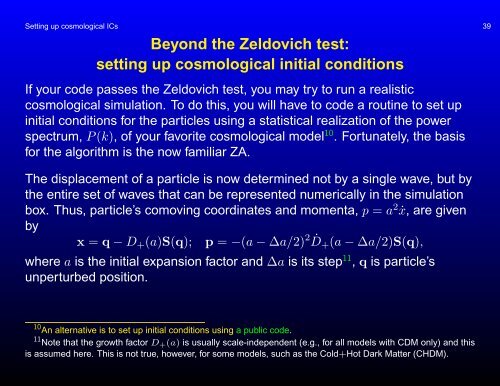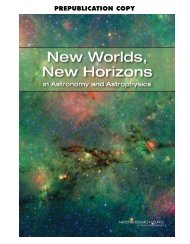Monday, 07/24: Writing a pm-code - AIP
Monday, 07/24: Writing a pm-code - AIP
Monday, 07/24: Writing a pm-code - AIP
You also want an ePaper? Increase the reach of your titles
YUMPU automatically turns print PDFs into web optimized ePapers that Google loves.
Setting up cosmological ICs 39<br />
Beyond the Zeldovich test:<br />
setting up cosmological initial conditions<br />
If your <strong>code</strong> passes the Zeldovich test, you may try to run a realistic<br />
cosmological simulation. To do this, you will have to <strong>code</strong> a routine to set up<br />
initial conditions for the particles using a statistical realization of the power<br />
spectrum, P (k), of your favorite cosmological model 10 . Fortunately, the basis<br />
for the algorithm is the now familiar ZA.<br />
The displacement of a particle is now determined not by a single wave, but by<br />
the entire set of waves that can be represented numerically in the simulation<br />
box. Thus, particle’s comoving coordinates and momenta, p = a 2 ẋ, are given<br />
by<br />
x = q − D + (a)S(q); p = −(a − ∆a/2) 2 Ḋ + (a − ∆a/2)S(q),<br />
where a is the initial expansion factor and ∆a is its step 11 , q is particle’s<br />
unperturbed position.<br />
10 An alternative is to set up initial conditions using a public <strong>code</strong>.<br />
11 Note that the growth factor D+ (a) is usually scale-independent (e.g., for all models with CDM only) and this<br />
is assumed here. This is not true, however, for some models, such as the Cold+Hot Dark Matter (CHDM).
















